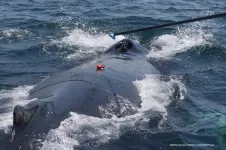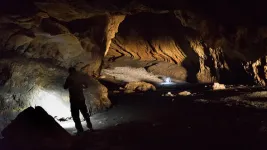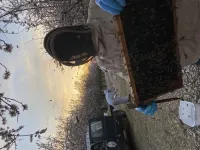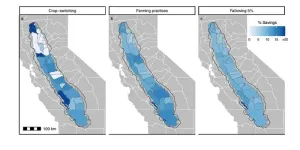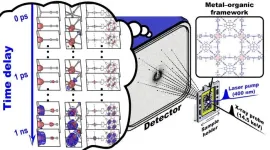(Press-News.org) University of Virginia researchers are developing a flexible online tool for navigating information used in the fight to save children from deadly diarrheal diseases by identifying transmission hotspots and accelerating the deployment of treatments and new vaccines.
Diarrhea not only kills hundreds of thousands of children around the world every year, it contributes to malnutrition that can prevent kids from growing and developing to their full potential both physically and mentally, trapping them in poverty. While significant progress has been made against the disease in recent years, the UVA researchers say that the modern era of “big data” offers a vast untapped opportunity to respond more nimbly and help more children.
Their Planetary Child Health & Enterics Observatory (Plan-EO) is bringing together the expertise of epidemiologists, climatologists, bioinformaticians and hydrologists (water supply experts) to provide an unprecedented, big-picture view of diarrhea around the world. The information and predictions that these experts come up with, will be hosted in a map-based online portal, giving infectious disease experts and local leaders in low- and middle-income countries the information they need to make smart decisions, prioritize resources and move quickly to save lives.
“Diarrhea is very much the great unmentionable public health threat, often ignored or seen as an unavoidable experience of childhood. We want to change that,” said epidemiologist Josh M. Colston, PhD, an assistant professor in the UVA School of Medicine’s Division of Infectious Diseases and International Health, who is leading the initiative. “As patterns of infectious diarrheal diseases shift due to climate change, we want the public health community to be ready and have all the most up-to-date epidemiological estimates and predictions at their fingertips.”
Addressing Childhood Diarrhea
To build out the new online dashboard, Colston is collaborating with experts in UVA’s School of Engineering, School of Data Science and Biocomplexity Institute, as well as colleagues at Johns Hopkins University. They are taking a multidisciplinary approach to a complex problem, seeking to capitalize on a vast array of expertise and build on longstanding relationships with collaborators overseas.
The researchers say that as climate change accelerates, the need to track diarrhea’s spread is only increasing. Flooding, for example, can help spread dozens of bacteria, viruses and parasites that cause diarrhea, worsening the situation in areas already reeling from the effects of the weather. That’s why it’s important for UVA’s project to include hydrologists, climatologists and experts in areas that go beyond infectious disease, the researchers say.
“Awareness is really growing that diseases have multi-faceted risk factors that encompass environmental, social and behavioral elements. We saw that with the pandemic, and we certainly see it with diarrheal diseases. That’s why a collaborative approach is crucial,” said Margaret Kosek, MD, professor of medicine and an infectious-diseases clinician. “We’re fortunate here at UVA to have experts in all these aspects all on the same Grounds, as well as the support to bring them together.”
Vital Data at a Glance
The new online dashboard, now under construction, will be updated continually to provide the latest data on pathogen dynamics, akin to John Hopkins’ invaluable COVID-19 dashboard during that pandemic. Visitors to the Plan-EO site will be directed to a world map-based interface where they can select data on specific diarrhea-causing pathogens, such as E. coli or Shigella bacteria.
The dashboard will allow researchers and leaders to understand the magnitude of the disease burden and predict the potential implications for the children living in endemic areas. It will also allow infectious disease experts and local leaders to coordinate the best strategies for responding to and containing the outbreaks, ultimately saving lives.
“Let’s say you’re an epidemiologist in Africa or South Asia and you’re interested in a specific community in a particular country to carry out a water-improvement project or vaccine trial,” said Venkat Lakshmi, hydrologist and John L Newcomb Professor of Engineering in Civil and Environmental Engineering. “Using the Plan-EO interface, you’ll be able to navigate to that location on a map and get robust predictions of the prevalence of particular pathogens, as well as published information on studies that have been carried out in the surrounding areas. It’ll be a gamechanger.”
The researchers plan to launch the dashboard later this year, with assistance from capstone students at the UVA School of Data Science.
Findings Published
The researchers have described their ambitious project in the scientific journal PLOS One. The research team consists of Colston, Bin Fang, Eric Houpt, Pavel Chernyavskiy, Samarth Swarup, Lauren M. Gardner, Malena K. Nong, Hamada S. Badr, Benjamin F. Zaitchik, Lakshmi and Kosek. The researchers have no financial interest in the project.
The work is being supported by the National Institutes of Health’s National Institute of Allergy and Infectious Diseases, grants 1K01AI168493-01A1 and 1R03AI151564-01; the National Science Foundation, Expeditions in Computing grant CCF-1918656; NASA’s Group on Earth Observations Work Programme, grant 16-GEO16-0047; and UVA’s Engineering in Medicine program, Department of Internal Medicine and Division of Infectious Diseases and International Health. Additional funding was provided by the Bill & Melinda Gates Foundation, grant OPP1066146.
To keep up with the latest medical research news from UVA, subscribe to the Making of Medicine blog at http://makingofmedicine.virginia.edu.
END
Online dashboard to help fight to save children from deadly diarrheal diseases
2024-03-25
ELSE PRESS RELEASES FROM THIS DATE:
Caller ID of the sea
2024-03-25
For researchers studying the acoustic behavior of whales, distinguishing which animal is vocalizing is like a teacher trying to figure out which student responded first when the entire class is calling out the answer. This is because many of the techniques used to capture audio record a large sample size of sounds. A major example of this is passive acoustic monitoring (PAM), which records audio via a microphone in one location, usually a stationary or moving platform in the ocean. While this method allows researchers to gather acoustic data over a long time period, it ...
SwRI develops more effective particle conversion surfaces for space instruments
2024-03-25
SAN ANTONIO — March 25, 2024 —Southwest Research Institute is investing internal funding to develop more effective conversion surfaces to allow future spacecraft instruments to collect and analyze low-energy particles. Conversion surfaces are ultra-smooth, ultra-thin surfaces covering a silicon wafer that convert neutral atoms into ions to more effectively detect particles from outer space.
Changing the charge of particles simplifies and enhances detection and analysis capabilities. Dr. Jianliang Lin of the Institute’s Mechanical Engineering Division and Dr. Justyna Sokół of SwRI’s Space Science Division lead the multidisciplinary project. The project builds ...
Novel quantum algorithm for high-quality solutions to combinatorial optimization problems
2024-03-25
Combinatorial optimization problems (COPs) have applications in many different fields such as logistics, supply chain management, machine learning, material design and drug discovery, among others, for finding the optimal solution to complex problems. These problems are usually very computationally intensive using classical computers and thus solving COPs using quantum computers has attracted significant attention from both academia and industry.
Quantum computers take advantage of the quantum property of superposition, using specialized qubits, that can exist in an infinite yet contained number of states of 0 or 1 or any combination of the two, to quickly ...
Persian plateau unveiled as crucial hub for early human migration out of Africa
2024-03-25
A new study combining genetic, palaeoecological, and archaeological evidence has unveiled the Persian Plateau as a pivotal geographic location serving as a hub for Homo sapiens during the early stages of their migration out of Africa.
This revelation sheds new light on the complex journey of human populations, challenging previous understandings of our species' expansion into Eurasia.
The study, published in Nature Communications, highlights a crucial period between approximately 70,000 to 45,000 years ago when human populations did not uniformly spread across Eurasia, ...
Honey bees at risk for colony collapse from longer, warmer fall seasons
2024-03-25
PULLMAN, Wash. – The famous work ethic of honey bees might spell disaster for these busy crop pollinators as the climate warms, new research indicates.
Flying shortens the lives of bees, and worker honey bees will fly to find flowers whenever the weather is right, regardless of how much honey is already in the hive. Using climate and bee population models, researchers found that increasingly long autumns with good flying weather for bees raises the likelihood of colony collapse in the spring.
The study, published in Scientific Reports, focused on the Pacific Northwest but holds implications for hives across the U.S. The researchers ...
20,000 years of shared history on the Persian plateau
2024-03-25
All present day non African human populations are the result of subdivisions that took place after their ancestors left Africa at least 60.000 years ago. How long did it take for these separations to take place? Almost 20.000 years, during which they were all part of a single population. Where did they live for all this time? We don’t know, yet.
This is a conversation that could have taken place one year ago, now it is possible to give clearer answers to these questions thanks to the study recently published in Nature Communications (1) led by the researchers from the University ...
New UM study reveals unintended consequences of fire suppression
2024-03-25
MISSOULA – The escalation of extreme wildfires globally has prompted a critical examination of wildfire management strategies. A new study from the University of Montana reveals how fire suppression ensures that wildfires will burn under extreme conditions at high severity, exacerbating the impacts of climate change and fuel accumulation.
The study used computer simulations to show that attempting to suppress all wildfires results in fires burning with more severe ecological impacts, with accelerated increases in burned area beyond those expected from fuel accumulation or climate change.
“Fire suppression has unintended consequences,” said lead author Mark Kreider, a Ph.D. ...
Small changes can yield big savings in agricultural water use
2024-03-25
(Santa Barbara, Calif.) — While Hollywood and Silicon Valley love the limelight, California is an agricultural powerhouse, too. Agricultural products sold in the Golden State totaled $59 billion in 2022. But rising temperatures, declining precipitation and decades of over pumping may require drastic changes to farming. Legislation to address the problem could even see fields taken out of cultivation.
Fortunately, a study out of UC Santa Barbara suggests less extreme measures could help address California’s water issues. Researchers combined remote sensing, big data and machine ...
Humans pass more viruses to other animals than we catch from them
2024-03-25
Humans pass on more viruses to domestic and wild animals than we catch from them, according to a major new analysis of viral genomes by UCL researchers.
For the new paper published in Nature Ecology & Evolution, the team analysed all publicly available viral genome sequences, to reconstruct where viruses have jumped from one host to infect another vertebrate species.
Most emerging and re-emerging infectious diseases are caused by viruses circulating in animals. When these viruses cross over from animals into humans, a process known as zoonosis, they can cause disease outbreaks, epidemics and pandemics such as Ebola, flu or Covid-19. Given the enormous impact ...
Filming ultrafast molecular motions in single crystal
2024-03-25
Understanding the behavior of matter is crucial for advancing scientific fields like biology, chemistry, and materials science. X-ray crystallography has been instrumental in this pursuit, allowing scientists to determine molecular structures with precision. In traditional X-ray crystallography experiments, a single crystal is exposed to X-rays multiple times to obtain diffraction signals. This poses a problem, where the sample has its structure altered or damaged by X-ray exposure.
In recent years, advances in technology have allowed for the development of “time-resolved serial femtosecond crystallography” (TR-SFX). In serial ...


